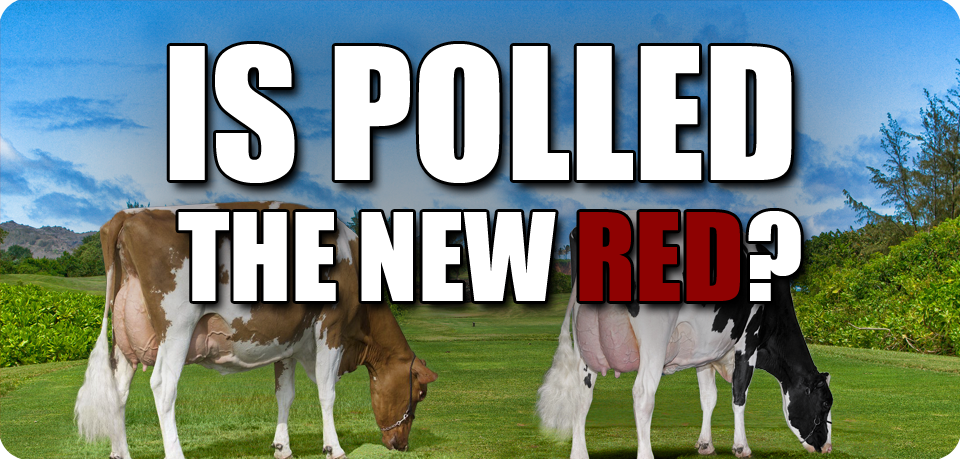For years breeders who were looking for something a little different could use a Red and White sire. While this meant usually using a sire of lesser overall genetic merit, the resulting unique colour often made the reward worth it for many breeders. But it seems more recently some breeders have moved their focus from using red and white sire to polled sires. Prompting us to ask “Is Polled the New Red?”
Key reasons polled is the new red
- Consumer Demand
While consumers for the most part could care less what colour the cow their milk comes from, they do care about the treatment of the animals. This gives polled a significant advantage as it does not require the animals to be dehorned. (read more Polled Genetics: Way of the future or passing fad) - Herd Advancement
For years breeders have had the enjoyment of breeding for R&W calf, the motivation for such was mostly personal. Contrary to that, polled breeding offers more direct herd impact in the need or should we say no need since you don’t have to de-horn calves. - Revenue Potential
While the opportunities to breed some of the top index cattle in the world to red and white or polled sires has existed for years, for the most part they have been left as a niche market. But as more breeders look to see where the end user consumer market is headed, they have started to more and more use polled genetics on their top index cattle. As a result the prices for high index polled females have been sky rocketing lately. Ask anyone with a polled female at or near 2000 GTPI what kind of interest they are getting, and they will all tell you everyone is trying to buy them, and the A.I and embryo interest is extreme. (read more They’re Sold on Polled)
Will red & white survive?
This trend of breeders endorsing polled sires would cause some to wonder if that means the end of the red and white market. While yes both have traditionally played to niche markets and there are only so many niches to go around. I would say that for the most part polled is more opening up new markets as opposed to stealing the red and white market.
The other interesting part is when it comes to the show ring. The growth over the past 10 years in the red and white show market has been significant. To the point where you see more and more red and white animals that could compete in the traditional black and white classes. Since the traditional red and white breeders do so for the uniqueness, I would think that this trend would just continue. I have yet to find a breeder using polled sires to get the next Royal or Madison Grand Champion. Polled breeders are doing more for economic impact than show ring success.
The Bullvine Bottom Line
While there is no question that in the past 18 months or so the demand for polled genetics has gone to new heights. Prices for the top GTPI or LPI polled animals have reached outstanding levels. Never before have we seen the top index cattle being mated to what was a traditional “niche” market. While this will only have to rapidly improve the genetic gain and selection in the polled market, the polled market is very much a different segment of the marketplace than the red and white market. So yes, polled is way more “trendy” at this point and time than red and white, it’s more of a growth of new markets than a stealing of the red and white market.


















I am so glad to see dairy professionals start to shift their view to include how customers perceive our product. Not only does using polled genetics save us from one of the worst jobs on the farm, it provides a point of compromise that we can easily reach.
Polled is certainly a new trait that can add something special to all the high GTPI heifers out there. However, dehorning calves between 3-6 weeks of age can be done in about 15 seconds per calf. The distress to the calf is very minimal. Polled is nice but I don’t think we need to let the fringe groups tell us we have to use polled sires.
Thanks Greg,
And yes totally agree not letting fringe groups dictating is not good, but what happens when the general consumer jumps on? We do have to follow what the consumers want or we will have challenges.
Andrew